|
Week 3: August 15-21, 2013 |
Welcome
to the McGill Bird Observatory weekly report.
Click here for a complete listing of our archives.
Comments or
questions are welcome at "mbo AT migrationresearch.org".
|
PICTURE
OF THE WEEK: |
|
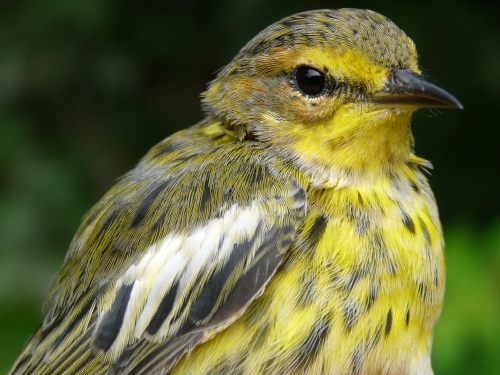
Cape May Warbler is a regular but uncommon migrant at MBO - the three banded
this week increased our total over nine years to just 47 individuals.
(Photo by Marcel Gahbauer)
-
|
|
|
THIS WEEK |
THIS FALL |
2013 TOTAL |
SITE TOTAL |
|
# birds (and species) banded |
170 (34) |
630 (48) |
1925 (82) |
43437 (113) |
|
# birds (and species) repeat |
48 (17) |
178 (28) |
508 (47) |
8489 (70) |
|
# birds (and species) return |
4 (4) |
19 (10) |
174 (30) |
1383 (38) |
|
# species observed |
95 |
107 |
157 |
208 |
|
# net hours |
560.0 |
1610.0 |
4966.8 |
74256.5 |
|
# birds banded / 100 net hours |
30.4 |
39.1 |
38.8 |
58.5 |
|
|
Note: table does not include nocturnal banding (owls) |
|
Banders-in-charge: Simon Duval, Gay Gruner
Assistants: Nicolas Bernier, Sue Bishop, Cindy Bouchard, Kim Bouchard, Marie-France Boudreault, Luke Currin, Rui de Jesus, Jean Demers, Barbara Frei, Jo-Annie Gagnon, Marianne Gagnon, Marcel Gahbauer, Nathalie Gendron, Alison Hackney, Leslie Hunt, Lisa Keelty, Ghislaine Laurin, Betsy McFarlane, Benoit Piquette, Catherine Russell, Ahmad Shah, Clémence Soulard, Patricia Stotland, Elise Titman, Rodger Titman
IMPORTANT: MBO has been selected as one of five finalists in the Jamieson Vitamins "Call for the Wild" contest for 2013. To support MBO, all you need to do is vote daily between August 19 and September 15 by visiting the contest Facebook page (no login required). Four other organizations are competing for their share of $100,000, and the amount allocated to MBO will be entirely dependent on the number of votes received. Please help us succeed with this important fundraiser by voting for MBO every day!
Notes: It was a relatively slow but steady week at MBO under sunny skies that allowed for full effort throughout the week. We banded between 15 and 33 birds daily, but diversity was good, with as many as 20 species on the final day of the week. The total of 170 birds banded this week was a bit above the long-term average of 147 for week 3. Observations were even better, with daily species counts ranging from 45 to 57 and a total of 95 for the week, miles ahead of the previous week 3 record of 85 species set just last year, let alone the mean of 78. Not surprisingly, the cumulative total of 107 is also well beyond the previous high of 102, also recorded last year.
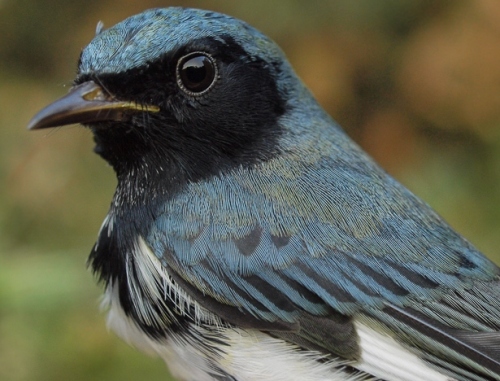
Although Black-throated Blue Warblers usually do not peak until late September, we have already banded four this fall, including the male above (photo by Simon Duval). Conversely, Traill's Flycatchers such as the one below are early migrants that we're unlikely to see at MBO beyond the end of August. This is one of the rare species to undergo its prebasic molt on its wintering grounds, so it is the adults like this one that look scruffy during fall migration (photo by Marcel Gahbauer).
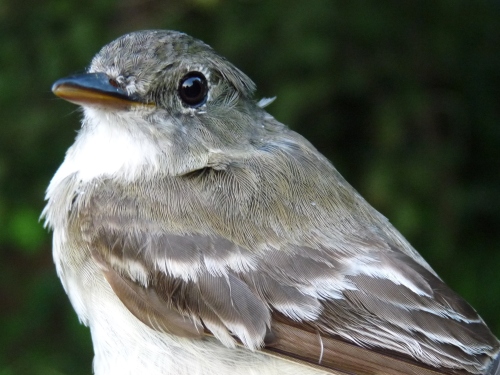
|
Among the rich variety of species observed this week were a dozen spotted for the first time this fall: Great Egret (in the back pond and the first for 2013), Cackling Goose (flying over, also the first for 2013), American Black Duck (flying over, but previously observed in spring), Olive-sided Flycatcher (hanging out with other flycatchers at Hummingbird Corner, another first for the year), Winter Wren, Golden-crowned Kinglet, Hermit Thrush (presumably a moult migrant), Cape May Warbler, Pine Warbler, Palm Warbler (yellow race), Wilson's Warbler, and Bobolink. Three of these species (Hermit Thrush, Cape May Warbler, and Wilson's Warbler) were also banded for the first time this season, and the thrush was the first of its kind banded this year.
This week’s top 10 [last week's rank in brackets]
# individuals banded |
mean # individuals observed daily |
1. American Redstart (29) [2] |
1. Cedar Waxwing (41) [1] |
2. Song Sparrow (22) [1] |
2. American Goldfinch (31) [4] |
3. Baltimore Oriole (10) [-] |
3. Black-capped Chickadee (21) [3] |
4. Tennessee Warbler (8) [-] |
4. Song Sparrow (19) [2] |
4. Common Yellowthroat (8) [4] |
5. American Crow (18) [6] |
6. Cedar Waxwing (7) [3] |
6. American Robin (15) [5] |
6. Canada Warbler (7) [10] |
7. Canada Goose (15) [-] |
8. Traill's Flycatcher (6) [7] |
8. Blue Jay (10) [7] |
8. Yellow Warbler (6) [-] |
9. American Redstart (9) [7] |
10. Rose-breasted Grosbeak (6) [7]
|
10. Ruby-throated Hummingbird (8) [-]
10. Baltimore Oriole (8) [-] |
|
This week's banding efforts were again dominated by American Redstarts and Song Sparrows, although they swapped positions from last week's list. Their prominence is not surprising - this is the fifth time in nine years that American Redstart has topped the list of birds banded in week 3, and it is the fifth time that Song Sparrow has been in the top two. Only in 2012 was a different species leading the way in week 3; that was Common Yellowthroat, which was tied for fourth place this week. It was tied with Tennessee Warbler, which typically peaks in September, and has never before ranked higher than 7th place this early in fall. Slipping into third place was Baltimore Oriole, with the second-highest ever count for week 3 - and a great relief to us, since the first two weeks of August usually represent the peak for this species, and we only banded a single individual over that period this year! Cedar Waxwing numbers continue to taper off, although this week's 7 individuals raised the season total to 73. Tied for sixth place was Canada Warbler, boosting its fall total to 12 individuals, approaching our long-term average for the season. Traill's Flycatcher reached the top ten for a second week in a row, but we expect their numbers will soon drop off as they are one of the earliest migrants to leave MBO. Rounding out the top ten, Yellow Warbler bounced back in, although still on pace for a record low fall total, while the steady flow of Rose-breasted Grosbeaks continued.
For a third consecutive week, Cedar Waxwing remained the most abundant species observed. American Goldfinch numbers continue to increase, rising to second place this week. Black-capped Chickadee and Song Sparrow counts were similar to last week, but they got bumped down to third and fourth place by the arrival of more goldfinches. Crows and robins again fit into the middle of the top ten. Canada Goose has historically not cracked the top ten until September - except last year when flocks also began to appear in week 3. It will be interesting to see whether this earlier movement of geese continues in future years. Blue Jays and American Redstarts both increased slightly in numbers this week, but dropped down the rankings compared to last week, reflecting the overall increase in birds in week 3. Two relatively unusual new additions tied for tenth place - Ruby-throated Hummingbird and Baltimore Oriole.
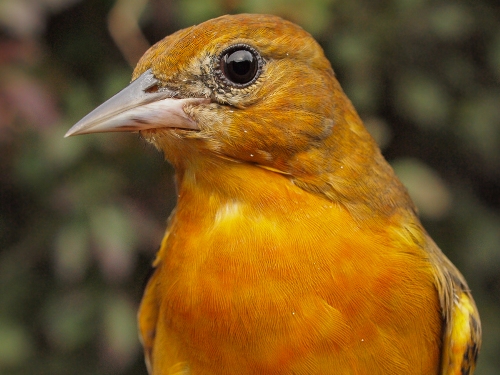
One of the ten Baltimore Orioles banded at MBO this week.
(Photo by
Simon Duval) |
Already the season is changing perceptibly, with more "mid-fall" migrants like Tennessee, Black-throated Blue, and Wilson's Warblers arriving. What more new species will arrive next week? Check back for our week 4 report at the end of August!
|
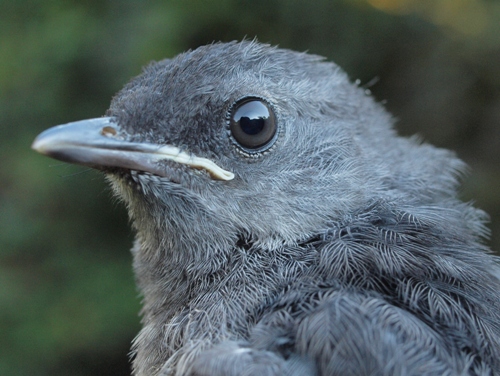
Although we are increasingly seeing migrants by mid-August, there are still a few local youngsters mixed in, like this Gray Catbird.
(Photo by Simon Duval)
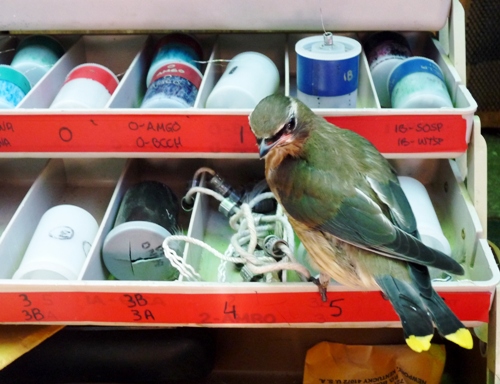
"Which one is for me?" On August 16, Simon Duval and Marcel Gahbauer visited Le Nichoir to band the birds they have been rehabilitating and will soon be ready for release. Among them were more than a dozen juvenile Cedar Waxwings, including this one that chose an unusually direct approach and landed on our banding kit to check out the selection of bands available!
(Photo by Marcel Gahbauer)
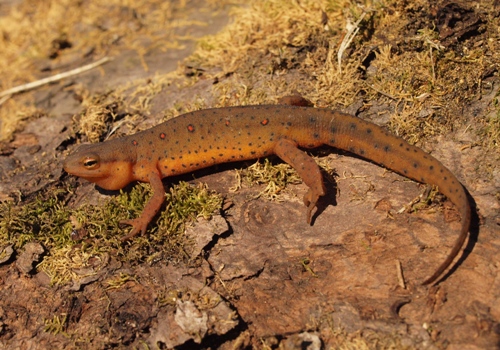
Continuing last week's theme of closing with a local herptile, here is a red-spotted newt that was wandering around near the banding cabin.
(Photo by
Simon Duval)
|







